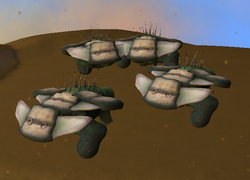Montothere
| Montothere | |
|---|---|
 | |
|
Homeworld: |
|
|
Diet: |
Plants, and a lot of them. |
|
Size: |
10 stories tall, weighs more than a hundred metric tons. |
|
Sapience: |
None |
|
Creator: |
|
|
Scientific Name: |
Montotherium magnus (Pinguinus, 2011) |
Montotheres are Gigantitheres native to the planet Aristotle. They are 6 stories tall and weigh almost a hundred metric tons. Their bodies provide habitat to many other species on the planet.
These are believed to be the largest animals in the Emenata universe. In fact, they are some of the largest known animals in all of Obeidon, after the Titans of the Daemoniverse.
Physiology
Appearance
Montotheres are giant, green animals with a wide, spreadout back and a hammerhead.
Adaptations for Gigantism
Montotheres have quite a few adaptations for their size. The below name just a few.
Skeletal and Muscular Systems
The bones in the Montothere's legs are a lot heavier and stronger than the ones in its back, and its skull. In fact, the upper body bones weigh hardly anything in comparison. The upper bones are built like a honeycomb; mostly hollow, but still strong.
The muscles are also extremely strong.
Circulatory System
In order to pump blood throughout its huge body, the Montothere has a massive heart. This is strong enough to circulate all of the animals blood throughout its body.
Respiratory System
Instead of having merely two lungs, the Montothere has a large number of smaller lungs located in it's wide back. Thus the Montothere can breathe easily, without a huge ammount of effort.
Diet
Montotheres have to eat 70 tons of plant matter every day to stay alive. Fortunately, the Rabbit Tree reproduces at an astonishing rate, and is capable of feeding this beast.
The green colouring of the Montothere is due to algae living on its skin. This algae supplements the animals body with various nutrients.
Behaviour
Montotheres, needless to say, have no natural predators, and they have a readily available food source. Therefore, they do not need much intelligence. They live in small herds comprised of around four or five individuals.
Migration
Every 60 years or so, Montotheres will migrate across Aristotle. They do this so the flora of the various regions has time to regrow. It could be considered a form of natural crop rotation.
Reproduction
To reproduce, montotheres must be pollenated, like plants. Their pollinators are the Cho'ghar, a sapient species living on their backs. The Cho'ghar regard this as a sacred duty.
Evolution
Montotheres evolved from a much smaller ancestor, about ten millions years BM. This ancestor was about twice the size of an elephant.
Discovery
Montotheres were first discovered by two Salsene probes.
Trivia
The montotheres' appearance is based on that of the Groveback, a vaguely similar creatures in Wayne Barlowe's book Expedition. Grovebacks also appeared in the Discovery Channels adaptation of the aforementioned work, seen on TV as Alien Planet.
I got the idea of many species of animals living on the montotheres from sloths. A two-toed sloth was once found with over 40 species of beetles living in its fur.
The word "Montothere" means "Mountain Beast" in Latin.

